Halogen lamps have been firmly established in the electrical equipment market for a very long time. And even now, in a century more high technology, despite the fact that, in fact, they are incandescent lamps with high energy consumption, the demand for them is not decreasing. And yet, many would like to replace the existing halogen lamps at home with a more economical lighting option - elements on crystals.
A person encountering LED lamps for the first time may think that there are no difficulties in replacing them. halogen lamps It cannot be on LEDs. It seems that the voltage is the same, and the base is suitable - change one for the other, and that’s it.
But not everything is as simple as it seems at first glance. Of course, with the same luminous flux, LEDs consume much less electricity, but without certain knowledge it is unlikely that it will be possible to replace halogen bulbs with them.
The fact is that the power supply for halogen lighting elements, although it provides the voltage they need at 12 V, does not stabilize it, which is necessary for normal functioning LED lamps. With such a battery, the flickering will be so sensitive and noticeable that you can forget about comfortable lighting. It makes sense to figure out how to replace halogen 12-volt light bulbs with LED ones, while getting even and clean lighting.
You can consider the possibility of replacement using the example of a chandelier with a remote control and with halogen lamps powered by 12 volts. One of the problems associated with replacement has already been mentioned - this is the receipt of an unstabilized current at the output of the transformer. But there are a couple more complications that are important to be aware of.
Firstly, the transformer feeding 20-watt lamps will begin to operate unstable when the power is reduced, which is inevitable when installing LEDs up to 1–1.5 watts per lamp.
Periodic power outages are also inevitable. Of course, not all such devices are susceptible to this “sore”, but still many of them are.
Well, secondly, oddly enough, when completely replacing lamps from halogen G4 to LED, the remote control for the chandelier ceases to control the lighting device. It is only enough to turn it on; other commands have no effect on the chandelier. Moreover, if not all, but only part of the light bulbs are replaced, the remote control operates in normal mode. This happens for the reason that the power consumed by the diodes is so small that the transformer stops fully powering the control unit, leaving it with only one main function.
So, where do you start to remodel a chandelier, considering all the problems associated with replacing halogen lamps with LEDs?
A 12-volt chandelier with a remote control, like all lamps of similar types, contains in the circuit three transformer blocks designed for halogen lamps, an LED control unit (one group on the chandelier initially consists of this type of elements and they can blink in two or three colors), and also a halogen lamp controller.
Next, you need to calculate what the total load on the stabilizers that will need to be installed will be. If there are 8 and 9 LEDs in two groups, the output will be 12 watts and 13.5 watts. For such a chandelier, you can choose good power supplies up to 15 W, which will be of a suitable size for placing them in the housing lighting fixture. Also, such stabilizers will protect against short circuits and voltage surges. Afterwards, you need to unsolder the wires from the power supplies for halogen lamps and connect them to the purchased devices for LED lamps. Now we install the lighting fixtures on the crystals, and the chandelier is ready.

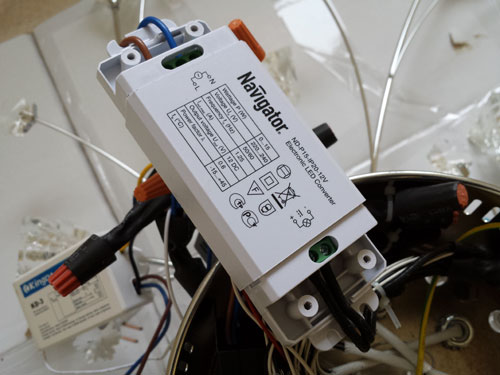
Using this action, all problems in the chandelier that appear when replacing lamps are immediately eliminated. The LEDs stop flickering, the light from them comes out smooth and clean, naturally, “dips” disappear, i.e. the stabilizer does not turn off due to the low power of consumers, and the remote control remote control works like a clock.
To change or not
In general, of course, remodeling a chandelier will take a lot of time, effort, and will also force you to invest financial resources. But the main advantages of such a replacement are that in addition to a longer service life, which is 30,000 hours for LEDs versus 4,000 hours for halogen lighting elements, there are also significant energy savings. After all, the power of a chandelier with G4 lamps on crystals will generally be 25.5 watts, while if there are halogen lamps, this parameter will be 340 watts. Therefore, such modernization will be quite appropriate and reasonable.
But there is one more parameter that must be taken into account when choosing light elements on crystals - this is their color temperature. You need to understand that more warm color will be more pleasing to the eye, but still, the colder it is, the brighter the luminous flux will be. This happens because the color temperature of a “warm” lamp (2,700-3,000 K) is much lower than the same parameter of a “cold” lamp (6,500 K). However, halogen lamps exist only at a temperature of 2,700 K.
LED lamps from spotlights
A very common type of lighting is 12 volt halogen ceiling lamps. Here, as with the chandelier option, you will need to replace the power supply with a driver that stabilizes the voltage for comfortable work LEDs.
Well, then you just need to replace the halogen bulb with an LED one. This is quite simple, of course, for those who have changed the lamp in a similar lamp at least once. The main thing is not to forget about precautions when working with dangerous voltage. It is imperative to turn off the voltage before performing any manipulations, since electrical installation work with the power on is not permitted, according to safety regulations.
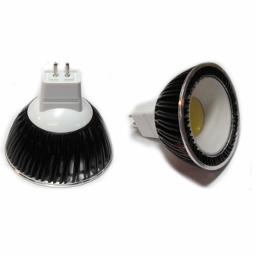
It can also be made using a housing from a used halogen lamp with a 12 V G4 base. But the process is labor-intensive and requires at least basic knowledge in electrical engineering and skills in working with a soldering iron.
Other replacement options
The fact is that halogen lamps do not only have pin sockets, such as G4. Nowadays it is very easy to find E27 screw light bulbs on the shelves of electrical stores. These can be installed instead of conventional incandescent lamps, and they operate from a network with a voltage of 220 V, and not from 12 V. The advantage of this type of lighting device is that such a base is universal.
Instead of a halogen lamp, you can install an incandescent lamp or even an LED lamp in the socket. Conveniently, LED lighting elements with a similar base are already equipped with a driver, and therefore, when replacing, nothing is required except, of course, the 220 V light bulb itself.
In cases of 12-volt equipment, you will have to spend money on a stabilizer or make it yourself, which is very labor-intensive and difficult. Although with certain knowledge and skills, and perhaps without them, but with a great desire and “hands from the right place” it is quite possible.
So which is better?
Whether or not to replace halogen lamps with G4 12 V LED lamps in an apartment is, of course, a difficult question. On the one hand, energy savings and a much longer service life of lighting devices on crystals. On the other hand, when replacing, you also need to invest. These are LED bulbs and a stabilizing device - a dimmer. Of course, after a short time the costs will be justified, but this will happen later, and you need to spend it now. Is it possible to give a satisfactory answer to this question? In any case, everyone must decide for themselves.
Halogen and LED lightening quite presentable and popular. Of these two options, it is sometimes difficult to choose a source for mounting in a chandelier. To avoid guessing for a long time and approach the procedure correctly: Replacing halogen lamps in a chandelier with LED ones , consider the impressive advantages of both contenders.
The first and significant factor is, of course, the time required for the light bulb to light up. If an incandescent lamp gradually becomes brighter, then the LED elements begin to fully emit light immediately after switching on.
Chandeliers of this type are less likely to fail, even if the switch is switched too regularly. The LED light source is absolutely safe for installation at home.
Positive features of halogen lamps
This chandelier has a convenient design component. The light source is capable of shining much brighter than the incandescent lamps we are used to. The bulb bulbs are made with quartz filler added to the glass. This shell option is very durable and airtight.
Halogen light bulbs get hot high temperature and are able to withstand it independently due to protective functions. In addition, they have the ability to withstand exposure to chemical irritants.
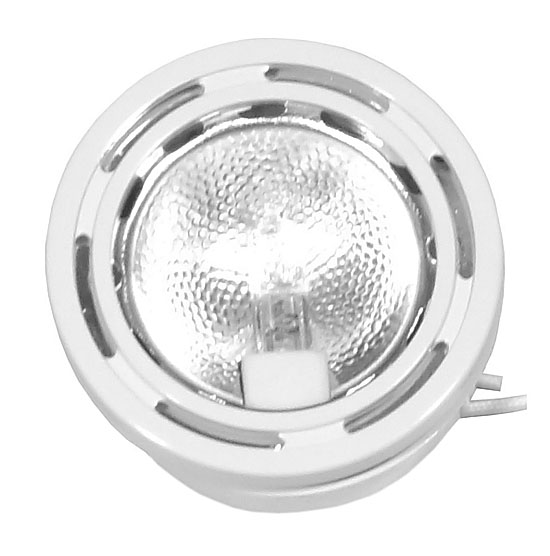
Basically, the goal replacing halogen lamps with LED lamps It is considered a common human desire to save energy. However, simply buying a light bulb with the same base and power is not enough. There are still a lot of subtleties hidden in the dismantling procedure.
What is the difficulty and can it be avoided?
In fact, replacing one light source with another is not an easy process and raises a number of questions.
- For example, an ordinary chandelier with 12-volt halogen lamps is not intended for changing sources, since it has a transformer installed that converts the standard voltage into that characteristic of halogen lamps. In such cases, it is better to change the chandelier.
- The next difficulty is that the transformers installed in halogen chandeliers do not respond to other light bulbs. In more detail, the LED element requires much less voltage than the native type; due to the low voltage, the transformer does not turn on.
- And again to the problem... Many chandeliers that work with halogen mechanisms have a remote control and when another source emitting light is installed in it, it stops working. The same thing happens with the switch, but it is able to turn on the device, and can only be turned off when the electrical network is completely de-energized.
How to change a halogen light bulb in a suspended ceiling?
Due to the desire to endlessly save light, many do not understand the importance of exchanging halogen lamps for an LED analogue. We have discussed the difficulties with you, and the conclusion is up to you whether it is worth resorting to such a procedure. For those who are not afraid of the task, we suggest that you refer to the instructions and read in more detail how the sources are replaced.
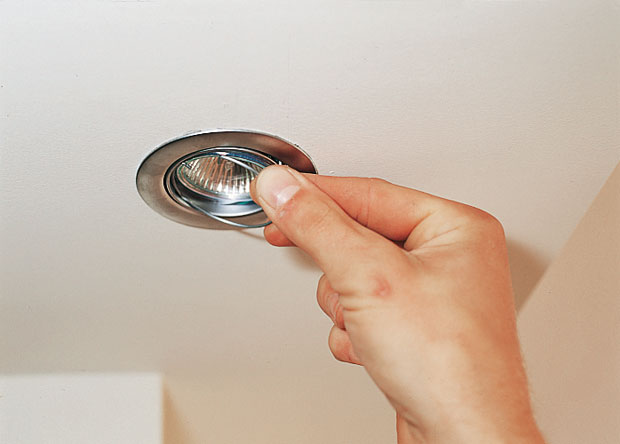
- Don't forget about de-energizing the room.
- The most important thing that is done first is to replace the internal mechanism of the chandelier, that is, the transformer with a driver. This device is capable of converting a current of 220 Volts into the required power for LEDs.
- The next thing is to remove the cartridge.
- Then the LED source is installed, all fasteners are put in place, if necessary, the wiring is insulated.
Don't forget to check the fixation of the chandelier.
How to replace a halogen lamp in a spotlight?
Taking into account each requirement, it is not necessary to invite a specialist to replace a halogen light bulb. The algorithm of actions is also simple: remove the fixing ring, remove the halogen light bulb from the socket, but not with bare hands, install a new one and do not forget to secure the lamp body. By turning on the electricity, you will understand whether you performed the actions correctly.
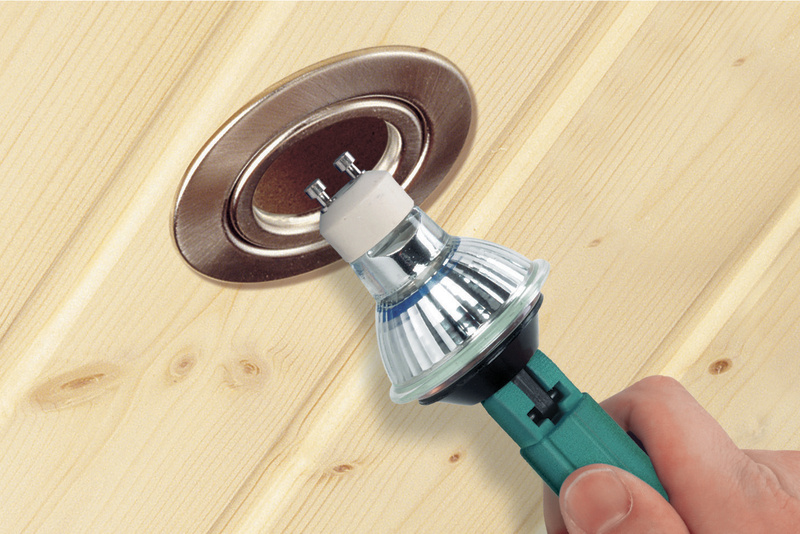
Spotlights also include LEDs; they are considered an excellent analogue, and are also safe and economical.
There is a good table lamp. It contains a halogen light bulb with a G4 base and 12V. Something like this
Moreover, the light bulb is protected by a glass shield. That, however, did not prevent the daughter from touching the shield with her finger and getting burned. I scratched my head - shouldn't I replace it with an LED with the same base? I googled it and got upset. It turns out that the so-called halogen lamps are widely used. electronic transformers not suitable for LEDs. People write en masse about replacing them with LED lamps specially designed for power supply. Okay, extra money - 10 bucks won't make a difference. But first of all, the base of the lamp where the transformer is inserted is quite compact and a replacement will not fit. And secondly, and even more importantly, the most ordinary trance standing there on an W-shaped core, with its significant weight, makes the lamp stable. If I replace it, it will fall.
Sadness...
I started making things up. The first thing that comes to mind, of course, is to leave the trans only for weight and find a 220B lamp. And the Chinese found them. And then in Leroy there is one, at 220B. It can be seen that in front of the LEDs there is a chip with 4 legs. The markings are not visible, but of course - a diode bridge (they sell it in chip and dip for 11 rubles). The LEDs themselves are clearly connected in series.
Looks like this is the solution! But, after thinking about it, I discarded this idea. Nobody promised me that the wire and base in which I now have a 12V halogen are designed for 220. That is, change. And this is a disproportionate gimor. We are looking further.
I found the same diode bridge on the chip and dipstick, tiny, it will fit in without any questions. I set out to study the choice of the necessary piping, a smoothing capacitor at least. And I came across a mention of 12 volt AC/DC lamps! Stsuko, that’s exactly what I need! Now, I know, I’m looking in the same Leroy - there is one for 12V AC/DC. No wonder I didn’t notice it right away - the title LED lamp WOLTA 2.5W 210Lm G4 12V warm. And it’s only written about AC/DC in the picture with the packaging! Stsuko, how tired I am of the widespread dominance of C students! Well, okay, imbeciles were recruited by advertisement to work in the hall; I haven’t spent time talking to them for many years. But a huge network made a catalog for itself on the website. Didn’t it really surprise you that they forgot to mention the operating voltage in the table of lamp characteristics? Printed in huge letters on the box, motherfucker.
PT415 is clearly readable on the chip. Which is easy to Google. The first assignment line is for replacing halogens with LEDs. The microcircuit even supports dimming - but it was not used in this assembly. I'm going to buy food.
I bought it, the only thing is that I mixed up warm and cold light, but in table lamp even better. Interestingly, the light bulb does not have a bulb as such. Filled with transparent plastic resin.
As expected, in a lamp with a real transformer with an W-shaped core, it burns perfectly. True, as expected, it does not respond to changes in the input voltage (there are two taps on the trance - for the maximum brightness of the halogen lamp and a weaker one).
At the same time, I tested it in a closet, where there are three halogen lights in the visor. There is an electronic "transformer". Everything is as people write. If there is at least one halogen, the LED lights up perfectly. If there is only one LED left, it lights up brightly, but flickers. So you will have to either leave the halogens or buy an LED driver. It’s good that there’s enough space at the top of the closet.
UPD from September 17, 2016 My wife said that the brightness in the table lamp is not enough. 2.5 W bulb, maybe... I found a 10 W LED bulb with 600 lm. Most of them are 5 and 300. Now there is enough light.
Surely, many owners of chandeliers or spotlights with halogen bulbs have more than once thought about replacing them with LED analogues. Mainly due to significant energy savings. However, it is not always possible to assess in advance whether such an exchange is really necessary. And in this article I want to show in practice what gives Replacing halogen lamps with LED lamps using the example of light bulbs with G4 socket.
In front of you different kinds light bulbs, but all with g4 socket
The top row shows halogen and LED bulbs for 220V, and the bottom row contains the same representatives, but for 12V. It is clearly noticeable that the dimensions of 220V lamps are slightly larger than 12V lamps.
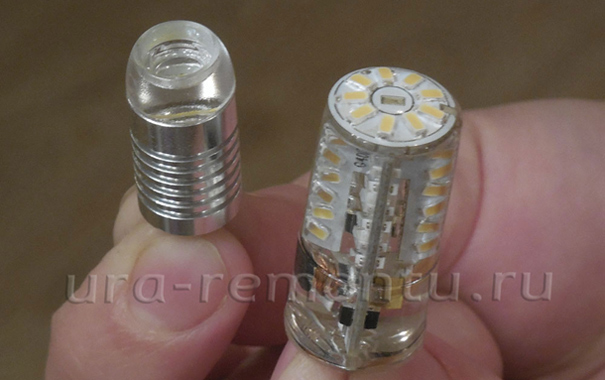
Two types of LED light bulbs with G4 socket - on the left is a light bulb with a single powerful LED and a diffuser lens, and on the right is a lamp with many LEDs, popularly called “corn”
What will we get from replacing a G4 halogen bulb with an LED one?
If we take a closer look at halogen and LED lamps, we will see that the filament in a halogen lamp is located closer to the base. While the emitting LED in an LED lamp is located much further from the base. As a result, we get a completely different lighting halo when used different types lamps
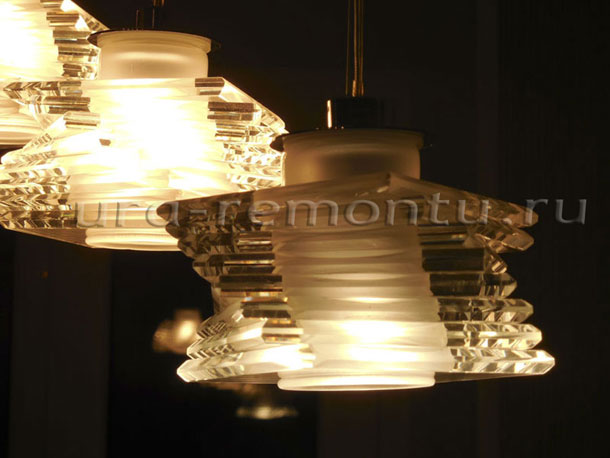
The left lampshade with a halogen lamp is fully illuminated,
while the LED light in the right lamp only illuminates its outer edge
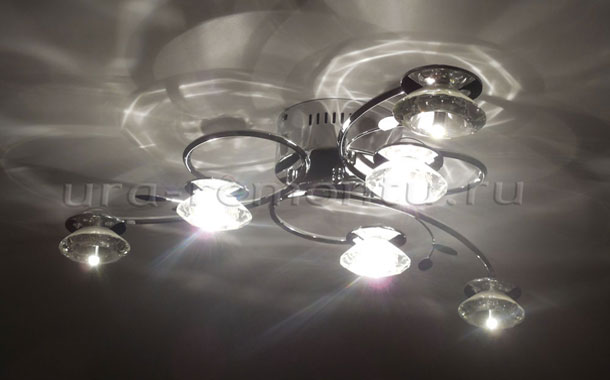
Here the halogen light also brightly illuminates the entire chandelier shade,
and the LED bulb does not illuminate the lampshade at all
For now, the advantages of halogen lamps are obvious, but we will not rush to conclusions and will continue our experiments on replacing halogen lamps with LED ones.
Let's compare halogen light bulbs designed for 220V and 12V.
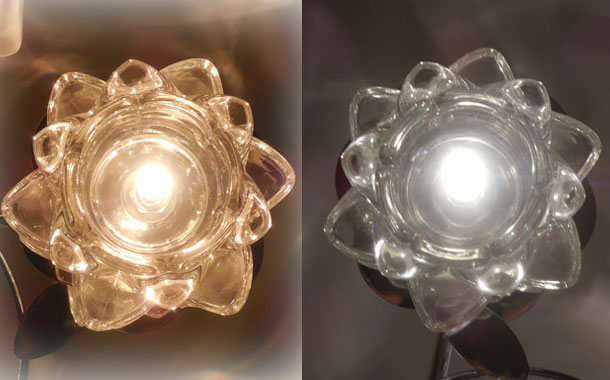
On the left, the 220V halogen lamp glows yellow,
and on the right the 12V halogen produces a white light that appears brighter.
Perhaps for this reason, most chandeliers and spotlights with compact shades and a G4 base are designed specifically for 12-volt halogens.
Let's look at how LED lamps of different voltages behave.

On the left, the 220V LED corn lamp lights up yellow,
and on the right is a lamp with a diffuse lens, but at 12V it gives white light
Important points when replacing a halogen lamp with an LED lamp with a g4 base
When replacing a halogen lamp with an LED analogue, it is necessary to take into account the following, in my opinion, the most important feature. A halogen lamp is essentially an incandescent lamp that shines in all directions. And the LED emits light only in one direction, which in space looks like a light cone. This is why almost all single LED bulbs have a diffuser lens. However, for some types of spotlights and chandeliers, a diffuse lens may not be effective. In this case, an omnidirectional LED corn lamp can partially correct the situation.
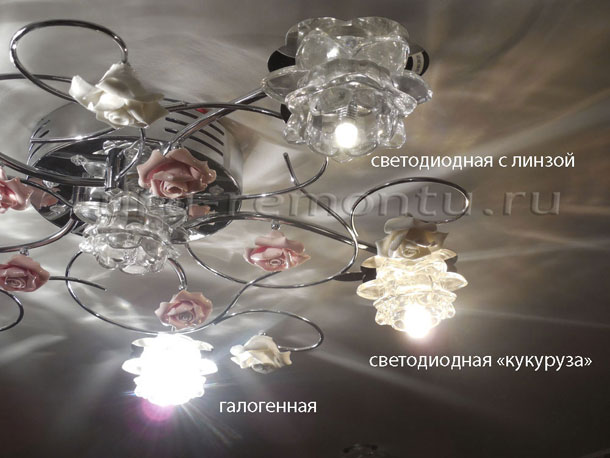
A striking example of comparing halogen and LED lamps in a chandelier with small shades
Now let’s compare the shape and size of the light spots produced by LED lamps of different designs.

In the photo from left to right: LED corn lamp, LED lamp with one LED and a diffuser lens, LED lamp with one LED but without a diffuser lens
As you can see, in this case, at the same power, a redistribution of the light flux occurs. In corn lamps, the luminous flux is close to a halogen lamp, and lamps with and without a lens have an increasingly concentrated luminous flux. This causes the illumination directly below the luminaire to appear stronger, while the overall illumination of the room appears insufficient.
Therefore, in this particular case, it is advisable to replace halogen lamps with LED “corn” lamps only in connection with the opportunity to save money on electricity.
In some types of lamps, due to the shape of the lampshade, even a halogen lamp sticks out, and when using its LED analogue, the protrusion of the light source becomes even more noticeable. When turned on, there is a change in brightness, and for the worse.
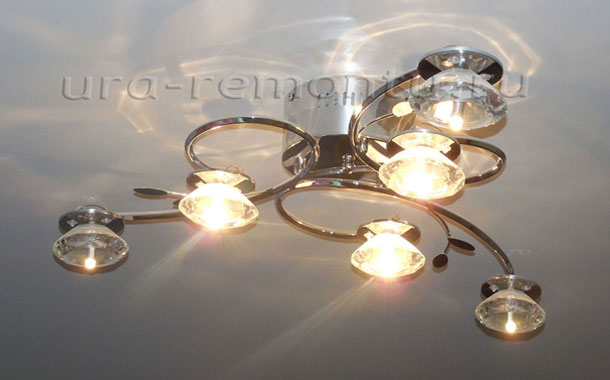
The central lampshades are illuminated by halogen lamps, which stick out slightly, the remaining lampshades are illuminated by LED lamps with one LED
Here we cannot say that it has become darker; rather, a redistribution of light has occurred. The stains on the ceiling have disappeared glass elements less filled with light, however, under the chandelier itself there is more than enough light, which cannot be said about the room itself. It's all due to the direction of the LED glow.
The pitfall of replacing halogen lamps with LED lamps
When replacing halogen lamps with LED lamps, it was detected next feature: 220V LED lamps shine brighter than 12V lamps with the same power and luminous flux. What causes this anomaly, since the LED itself is a low-voltage device and operates on several volts, just remember the famous LED strips?
Let's try to figure it out. LEDs operate on constant current. LED lamps designed for 220V inside have a miniature rectifier with a stabilizer, so they can operate on alternating voltage. In 12V LED lamps there is no rectifier, but there is always a diode bridge, which allows you not to worry about the switching polarity, but does not provide the declared brightness when operating on alternating current. Therefore, 12V LED lamps must operate on constant current, which can be provided by a special power supply or LED driver. And in halogen lamps, where we want to replace the lamp with an LED one, a special transformer is installed to power low-voltage halogen lamps, which is not intended for LEDs. That is, it is necessary additional expenses for the purchase and replacement of a transformer with an LED driver.
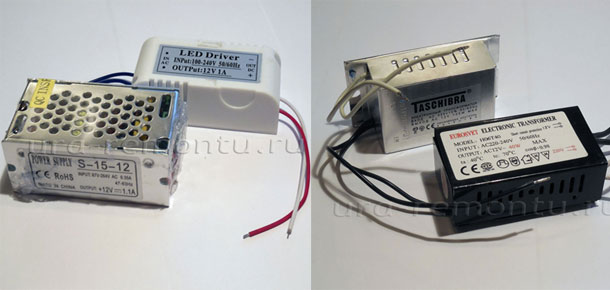
LED drivers for LED lamps and transformer for halogen lamps
What to do? Either come to terms with it and use higher-power analogues, or, best of all, replace that same “halogen” transformer with an LED power supply. But then you need to change all the lamps from the chandelier at once, not forgetting design features LED lamps.
When I was just planning to replace the halogen light bulbs in my apartment with LED ones, I watched several videos that were clearly in favor of LED sources, but in practice it turned out not to be so simple. Replacing halogen bulbs with LEDs does not always make the room brighter - here big role plays a role in the shape and size of the spotlight or a lampshade in a chandelier. I hope my article helped you decide whether you need such a replacement.
Another review of LED lamps.
The impetus for writing a review was the fact that by searching the resource I could not find reviews of a similar product. When the review was half finished, I looked through MySKU again (well, it can’t be!), and finally found it. But don’t let what you write go to waste. :)
I hope that I will help all owners of chandeliers with a similar form factor of light bulbs. Such lamps in the “halogen” version burn out quite often, they consume an appalling amount of energy by modern standards, they consume electricity very inefficiently, and it is somewhat more difficult to find them in stores than the classic E14 and E27.
Will it be possible to replace them with LEDs?
Let's take a closer look at the light bulb. 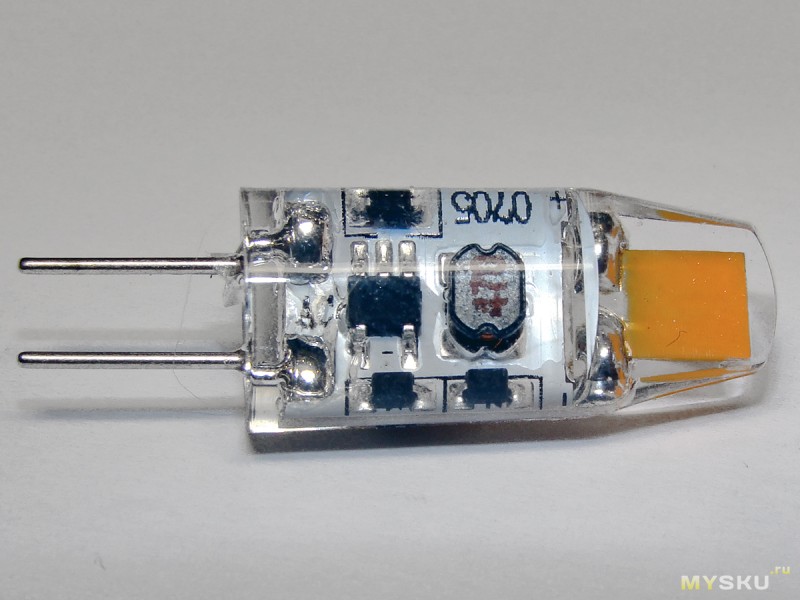
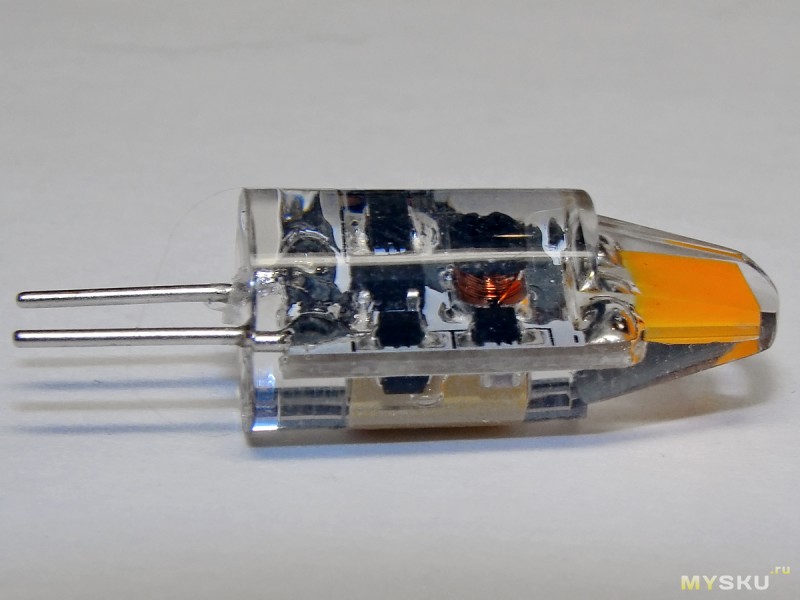
The first thing that catches your eye. Contrary to the established Chinese tradition (for the sake of saving space and money in silicone fills, there have already been reviews, installing passive ballast from a damping capacitor), in these lamps, to our joy, there is, albeit a simple, but quite a driver. It's hard to see through the silicone, and the tracks apparently can't be traced at all, but you can see something.
We see, obviously, a PWM controller. We see the motor choke (which is good). Apparently, we see diodes.
It’s hard for me to say for sure whether these are diodes, but the lamp is definitely non-polar. It works exactly the same regardless of the polarity of the voltage supplied to its legs. That's a plus. This means that the lamp will work with any power source (including “electronic transformers” for halogen, classic low-frequency transformers, stabilized power supplies, etc.). 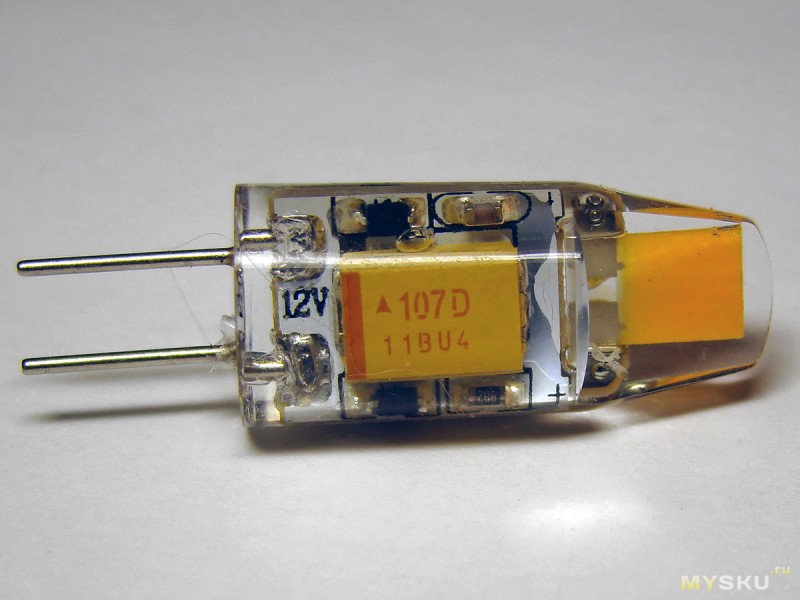
WITH reverse side we see a small ceramic capacitor, some kind of resistor, and in the center of the composition - a polar capacitor of as much as 100 microfarads. In the vastness of Ali, judging by the product pictures, you come across light bulbs with capacitors of smaller capacity. There is only one principle: the larger the capacity of the smoothing capacitor, the less the lamp will flicker, the less harm it causes to the eyes.
Let's compare this light bulb with a classic halogen 20W 12v 
Let's take the caliper
Diameter: 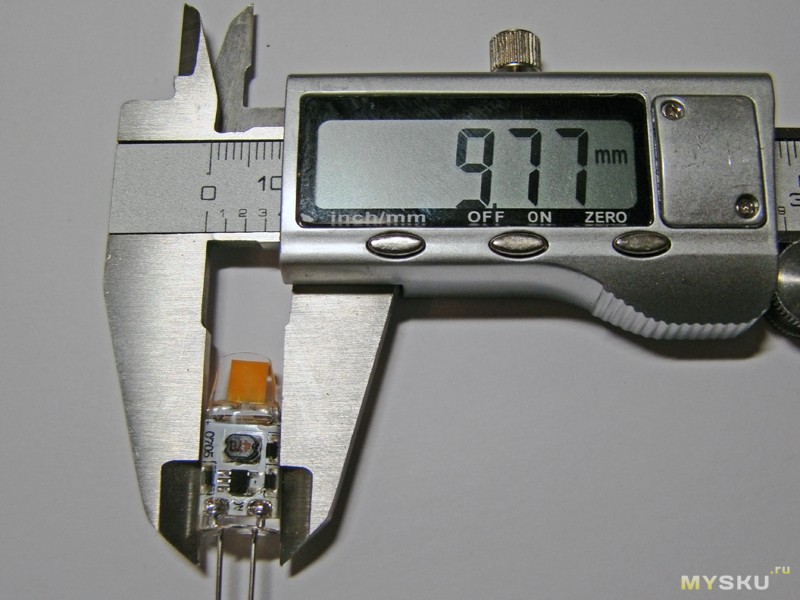
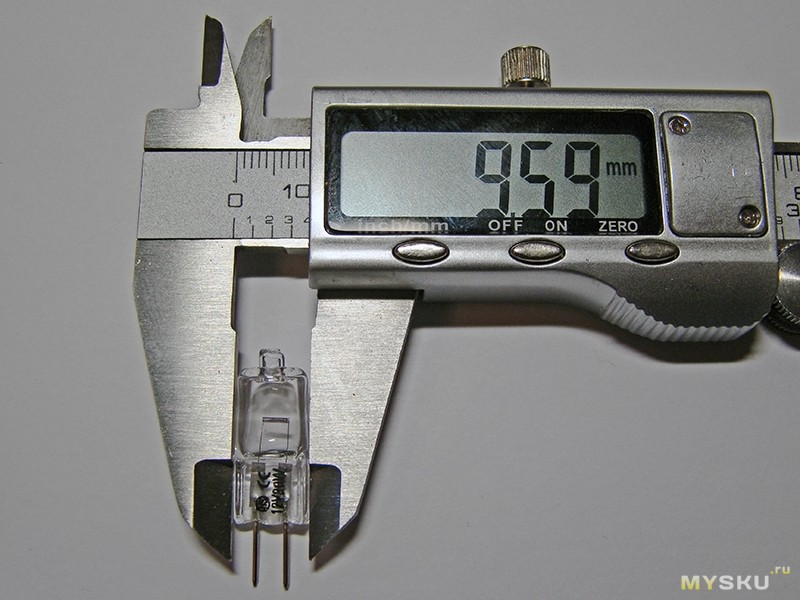
Two tenths of a millimeter. No one makes holes in lampshades with such precision.
We can say that they are the same in diameter.
Length: 

Half a millimeter. Error in the softness of silicone and glass sprue for halogen.
And they match in length.
Now we move from geometric measurements to electrical ones.
Source voltage 12.38V 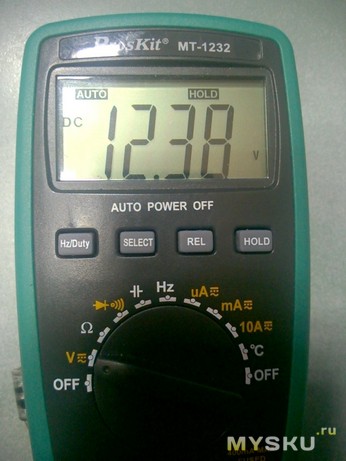
We measure the current. A little more than 90mA 
Total real power is 1.2 W.
Of course, there is no need to talk about any 3W from the title. And this is another unbreakable Chinese tradition. But that's not even bad. Because these honest three watts from the silicone would have to go somewhere, but there are no radiators here. For the same reason, I think you should not buy such lamps in the 6W version, they will shine brighter, but the thermal regime will be more difficult.
By the way, since we're talking, it's time to take your temperature.
I measured it with a thermocouple, pressing it forcefully into the silicone.
I couldn’t get more than 68°C, no matter how hard I tried. 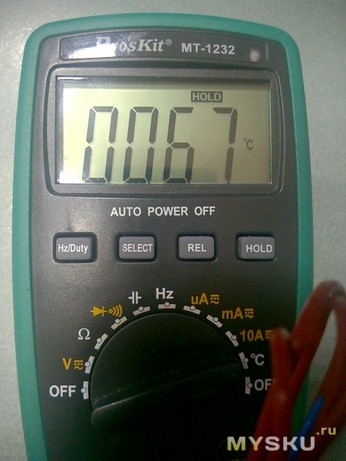
It's hot, of course. But it could have been worse. They'll live.
And finally, the main question.
Color comparison.
I put the camera in manual mode, I take both frames with the same parameters. I shoot from the same position on a tripod. ![]()
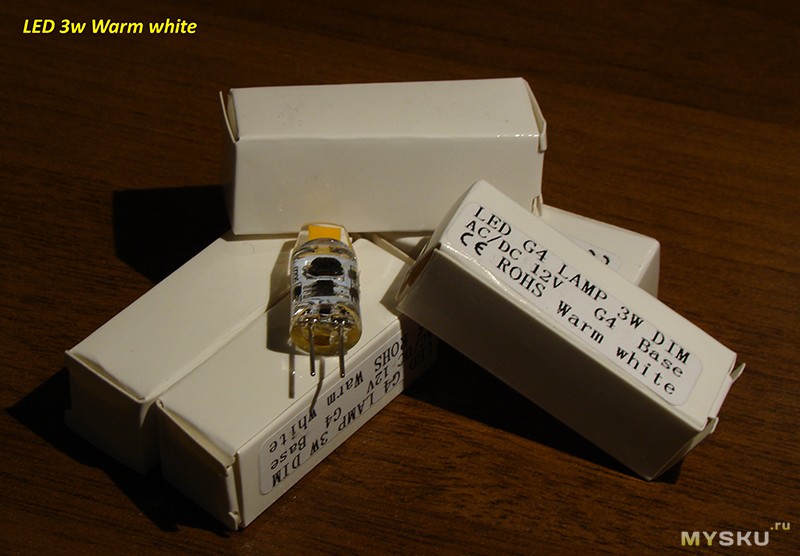
First the halogen, then the monitored bulb.
There are no striking differences. And this is unexpected. The bulb under review is slightly green (almost not noticeable), the halogen is a little brighter.
I’ll be honest, I was expecting either a goggle-eyed greenish look, or yellowness, or (hello to Feron) a general fall into the pink-violet area. No. The feeling in reality is quite comparable to an incandescent paw.
Let's put it in the chandelier. 
I specifically pressed down the aperture and set a low shutter speed so that the frame would be slightly darkened, but this way the overexposure would not interfere.
In this frame, out of ten lampshades, six are equipped with monitored lamps, four with classic halogen lamps. I assure you, if you don’t look closely, there is practically no difference.
No flickering was detected by any of the methods, thanks to the 100uF capacitors.
After some thought, I decided that, perhaps, I would not change the four remaining halogens. I saved electricity. Increased the efficiency of the chandelier. But the spectrum in the room will still be smoother.
Conclusion: Unexpected good product. It will successfully replace a halogen lamp in all respects: in size, in glow color, [almost] in glow intensity, in unpretentiousness to the power source. At the same time, it will consume almost 17(!) times less electricity and will not heat the air in the room. And you can touch, pick up and replace them simply with your fingers, without gloves or degreasers. :)
Yes, with such heating they do not last forever, but classic halogens still die more often. For almost 200 pure hours of operation, none of the six lamps showed signs of degradation.
PS: Despite the general tone of the review, no one provided me with anything or set any conditions. Everything was bought with my own money at full price, now it’s even a little cheaper.





